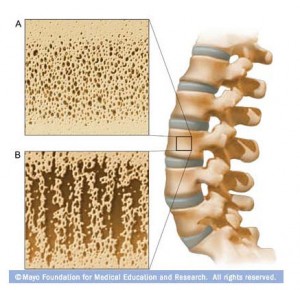DEAR MAYO CLINIC: What’s the difference between osteoporosis and osteopenia? Are they treated differently?
ANSWER: Osteoporosis and osteopenia are related conditions connected to bone health. Osteopenia can be a precursor to osteoporosis, but that is not always the case. Treatment for these disorders is similar because the treatment goals for both are to strengthen bones and slow bone loss.
Bones are in a constant state of renewal. Your body regularly makes new bone and breaks down old bone. When you are young, your body makes new bone faster than it breaks down old bone, and your bone mass increases. Most people reach their peak bone mass in their mid-20s to mid-30s.
As people age, bone mass is lost faster than it is created. That means the higher your peak bone mass is when you are young, the more bone your body has to sustain bone health throughout the rest of your life.
Osteopenia develops when a person’s bone density is below normal. This condition raises the risk of bone fractures. Osteoporosis occurs when the body’s creation of new bone can no longer keep up with the breakdown of old bone. This leads to bones becoming weak, brittle and easily broken.
Osteopenia and osteoporosis are often diagnosed based on results of a bone density test. The test measures how many grams of calcium and other bone minerals are in a segment of bone. Bones that are most commonly tested are in the spine, hip and forearm. The higher the bone mineral content, the denser the bones are. The denser the bones are, the stronger they are and the less likely they are to break.
Results of bone density tests are reported in a number called a T-score. A T-score of -1 or higher is considered normal. T-scores between -1 and -2.5 are labeled as osteopenia. A T-score of -2.5 or lower indicates osteoporosis. In some situations, a person may be diagnosed with osteoporosis if she or he has a bone that breaks easily, even if the T-score is not in the osteoporosis range.
Osteoporosis requires treatment. Treatment may be appropriate for osteopenia in some cases. Medications called bisphosphonates are often prescribed for people who have osteoporosis and osteopenia. These drugs are useful because they have been shown to slow the bone breakdown process. Examples of bisphosphonates include alendronate, risedronate and ibandronate, among others.
Getting enough calcium and vitamin D in your diet also can help keep your bones healthy. Men and women between the ages of 18 and 50 need 1,000 milligrams of calcium a day. This daily amount increases to 1,200 milligrams when women turn 50 and men turn 70.
Good sources of calcium include low-fat dairy products, dark green leafy vegetables, canned sardines with bones, canned salmon and soy products. Many cereals and juices also are calcium-fortified.
Vitamin D is necessary for your body to absorb calcium. People may get all the vitamin D they need from sunlight. If you’re diagnosed with osteopenia or osteoporosis, however, your doctor can do a blood test to check your level of vitamin D. If it is too low, you may need a vitamin D supplement.
Regular exercise can help build strong bones and slow bone loss, too. A combination of strength training exercises with weight-bearing exercises is usually best. Strength training helps strengthen muscles and bones in your arms and upper spine. Weight-bearing exercises — such as walking, jogging, running, stair climbing, skipping rope or skiing — have a positive effect on the entire skeleton and in particular benefit the bones in your legs, hips and lower spine.
Swimming, cycling and exercising on machines such as elliptical trainers can provide a good cardiovascular workout. Because these exercises are low impact, however, they are not as helpful for improving bone strength as weight-bearing exercises. — Bart Clarke, M.D., Endocrinology, Mayo Clinic, Rochester, Minn.







